The Nicest People On A HONDA~An advertising campaign that changed the image of motorcycles
As someone who mainly uses Honda motorcycles produced in the 1960s, I am interested in the motorcycle culture of this era.

It still cruises at high speeds, and on public roads it has such responsive driving that you're constantly being urged to rev up the engine, making you forget that this is a machine that was built nearly 60 years ago. On the lower roads, it is not difficult to lead the way in modern traffic conditions.
Come to think of it, the bike shop that sold it to me also told me, ``Hondas of this age are racey, so if you ride like a laid-back twin, you'll turn over, so be careful.''
It went beyond the scope of enjoying the retro feel of an old bike, and at times I felt it was darker than modern cars and bikes.
I wanted to know the background of the era in which this bike was born.
Motorcycles, cars, and other private vehicles reflect the values and culture of people at the time.
The 1970s had features and designs unique to the 1970s, and the 1980s had features and designs unique to the 80s. As is well known, from the 1970s onward, Japanese manufacturers including Honda overwhelmingly led the global motorcycle market.
However, in the 1960s, Japanese motorcycles were still far from being the world standard.
In order for the Beatles to become a global standard, as the Stones did, they needed to sell well in America.
In the 1960s, the standard motorcycles in America were Harleys, as well as British bikes such as Triumph, which was famous for racing, and German bikes like BMW.
Before participating in the four-wheel F1 race, Honda founder Soichiro Honda visited the Isle of Man TT race in the UK in 1954, the stage for the two-wheel race, and since then he has never won the world's highest motorcycle race. be kept in mind.
In the 1960s, Honda motorcycles not only continued to win in both the 125cc and 250cc classes in the World GP series, including the Isle of Man, but also dominated the top ranks, making them unrivaled.
It is a direct successor to the CB72, which was manufactured using the technology cultivated in the Isle of Man TT Race, and the CB250 I ride also has a passion for racing and is on its way to becoming the top of the world ( You can feel the breath of the air when you stood up.
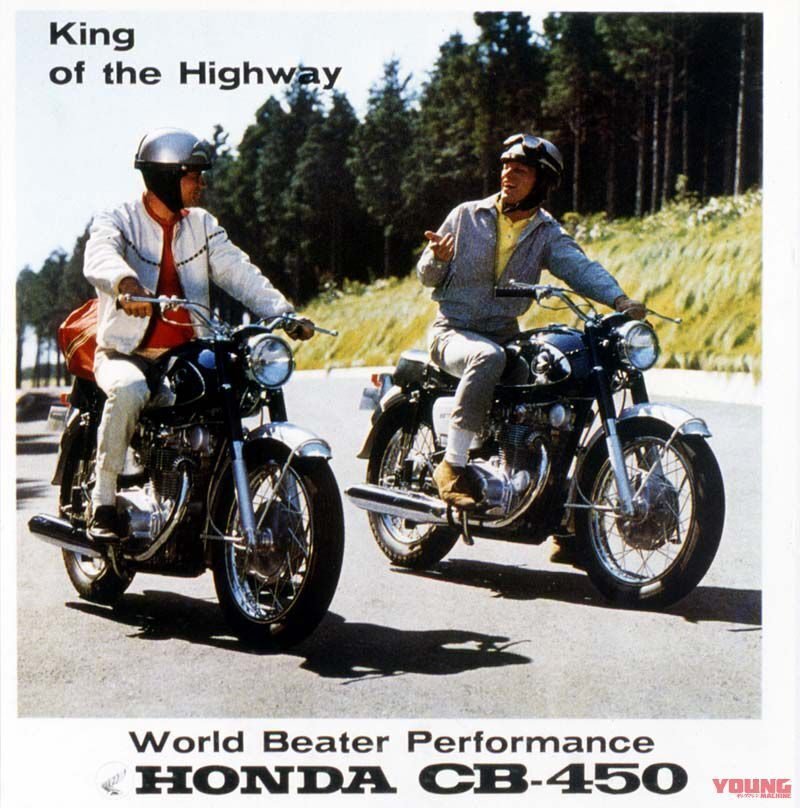
However, whether its unparalleled presence in racing has taken the American market by storm, the catalog explanation for the CB450, released in 1965, states, ``The world's best motorcycle manufacturer offers the world's best performance model.'' Although it was openly provoking foreign cars, it had to wait until the CB750 Four (released in 1969) to break through in terms of sales (from Young Machine ).
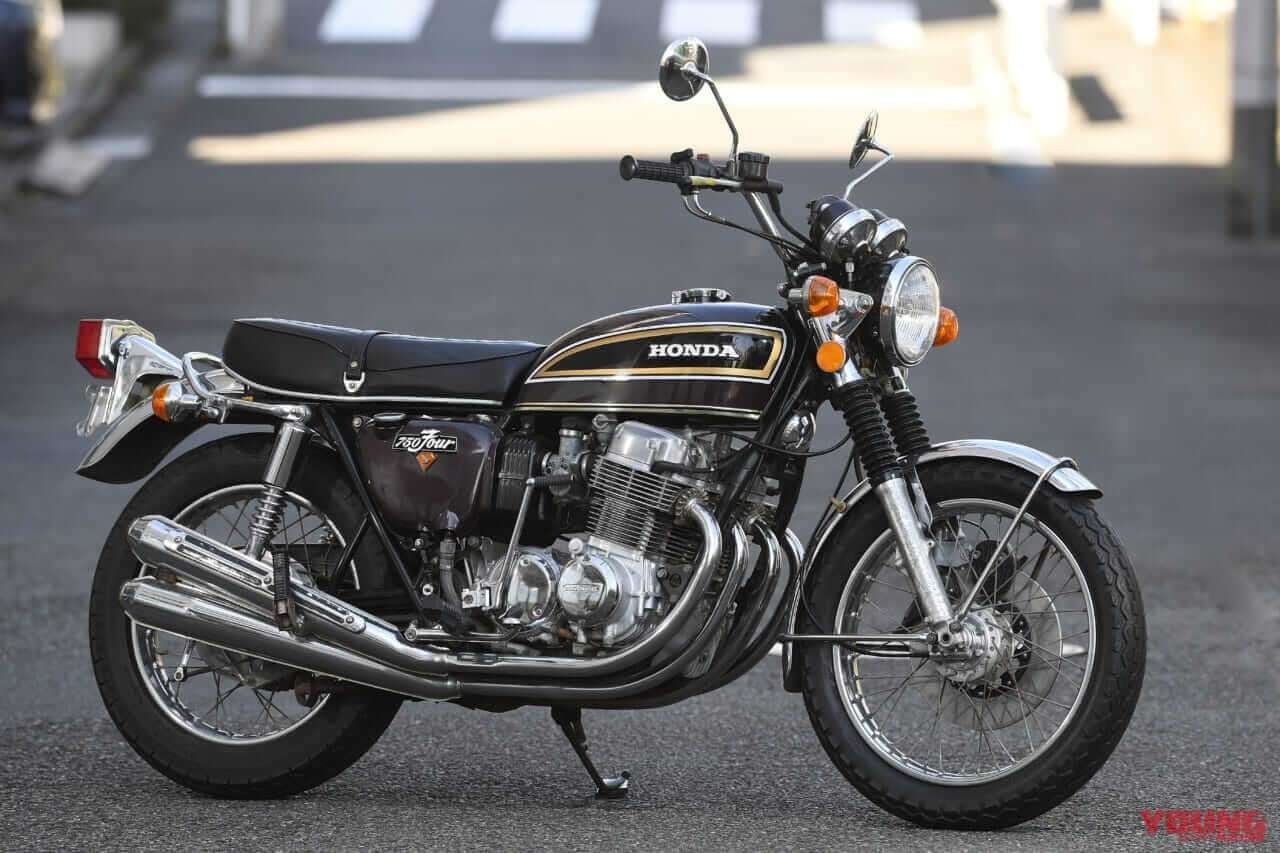
Even if they were perfect in terms of performance, the values and culture of people at the time (especially in America) gave the image of motorcycles as somehow delinquent, similar to Harleys and the Health Angels. In terms of performance, rather than eye-popping, instantaneous power, there was a need for stable torque that would allow the car to run at high speeds for long periods of time without getting tired.
It can be said that the market for high-performance motorcycles was not yet mature, but even today, the rugged and inferior quality of such motorcycles is still alive and well in terms of fashion.
It's like having a tattoo on your arm and riding a Harley.
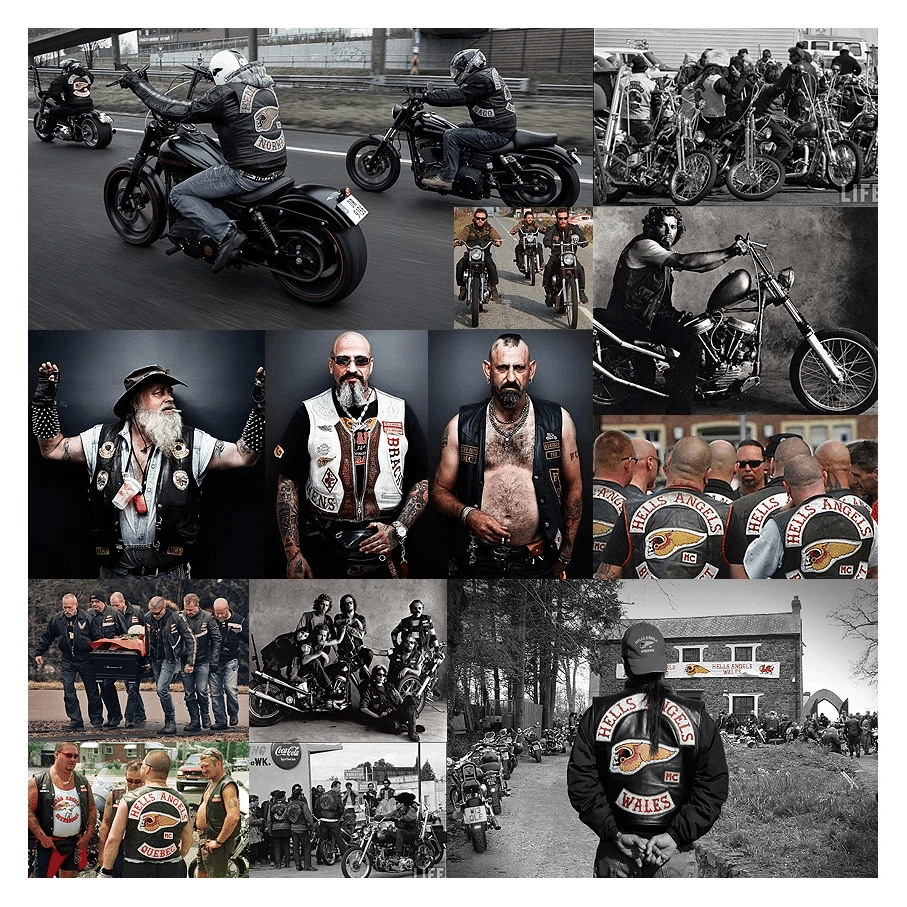
So, was Honda trying to sell its products in areas where there was no market demand?Even if there was no obvious (visible) demand, there was latent (inconspicuous) demand. There was a group of people who enjoyed the high performance and raging spirit of the engine. This is clear if you look at the rapid progress made by the company and other Japanese manufacturers since the 1970s.
However, it is difficult to continue producing products to meet latent demand. Honda aims to become a global company that makes ordinary people sing and dance like the Beatles and Stones (that's why they expanded into the United States), rather than an ultra-luxury fashion brand that only a few people can buy, such as highly ambitious researchers and athletes who reach the pinnacle. However, I feel that there is a certain naiveness about him that is reminiscent of a literary figure.
If we think of the company not as a blue-chip ideal but as a filthy corporate entity, it would not be surprising if it were criticized at a general meeting of shareholders, saying, ``Such latent demand does not exist, so don't make a product where there is no market.''
Honda did not give up. The presence of Soichiro Honda, an absolute charismatic figure, was probably a big factor, but I can imagine that the company required extraordinary strength, not only financially and physically, but also mentally.
Mission Impossible: If there's no market, create it yourself. However, this was not the company's first experience making the impossible possible.
In parallel with its racing activities, the advertising campaigns that Honda used in the early 1960s, mainly to sell the Super Cub to the United States, are notable.
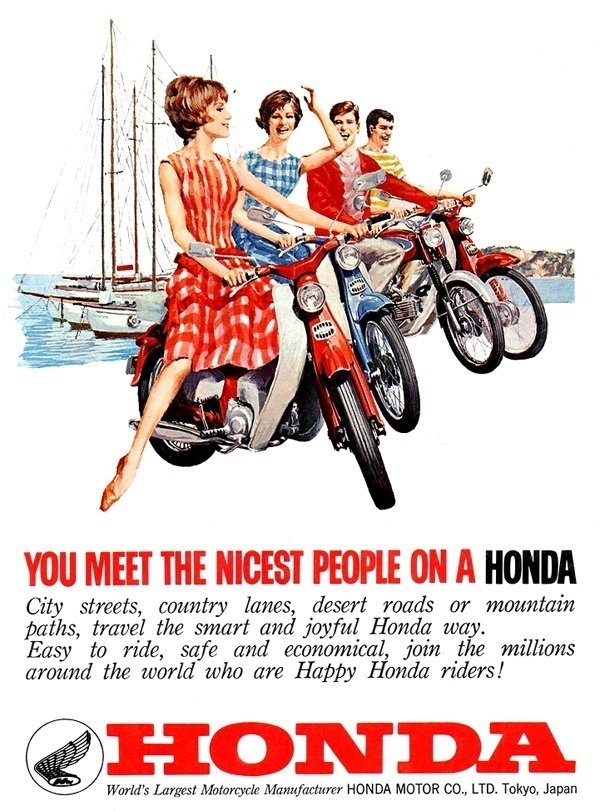
The Nicest uses the word "nice" in a way that makes me smile, but it's not like a traditional delinquent person, or a machine used for labor. , has succeeded in adding a fun lifestyle and a stylish atmosphere to the image of a motorcycle.
(The company soon took over the number one market share for motorcycles in the United States.)

Here, people are depicted enjoying the culture of motorcycles, regardless of ethnicity, occupation, class, or gender.
Not only the Cub, but also small and medium-sized cars are depicted with this image, adding a different image from the ``invincible high-performance bike in racing''.
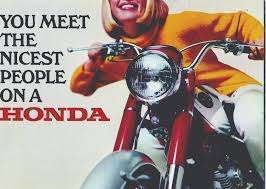
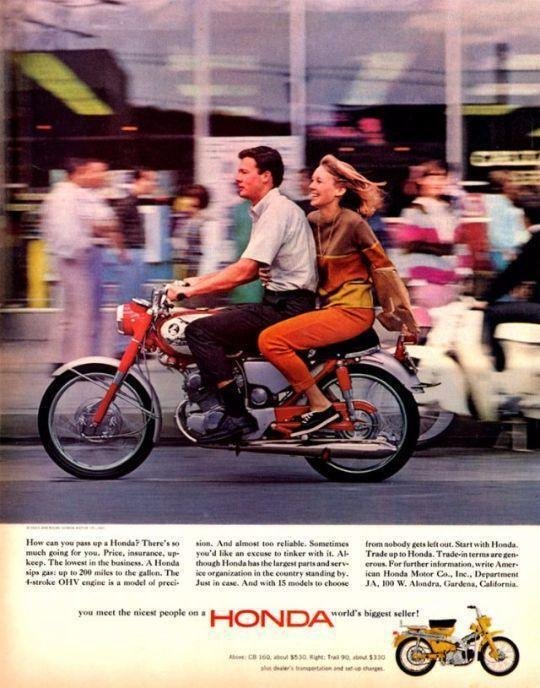
After that, Japanese motorcycles became a world standard and shaped a culture.
Motorcycles have become a lifestyle, depicted in music, novels, and movies as if they were the main character of the story.

In the 1980s, Taiwanese filmmaker Hou Hsiao-hsien captured sad and painful images of lovers and Honda motorcycles on film.

My personal impression is that the people who are currently capturing cars and motorcycles in a good way are directors in Southeast Asia and Instagrammers.
It's not a rehash of Western culture, it's enjoying MOTO culture, and it's all about old Japanese cars, Japanese motorcycles, old city pop, etc., which is interesting and very cool.

There is a huge market there. When it comes to motorcycles, Honda's sales volume in Southeast Asia is incomparable to that in Europe, America, or Japan.
In the past, selling well in America was a top priority, but now things are different. Naturally, a culture will be created as well. What about fashion?
Just to add to my personal impressions, I love Harley's delinquent look as a fashion, of course, but I wouldn't do it myself, or rather, I can't do it, it doesn't suit me. I'm sorry to say that I have a tattoo on my arm, but my bone and muscle mass is too different, and I love hot springs too much.
It's a bike with good response despite its small displacement, and it's styled mainly for city riding.

Compared to long touring, which requires heavy equipment due to weather changes and safety concerns, it seems like you can enjoy a variety of different styles of touring, which we introduce on our website.
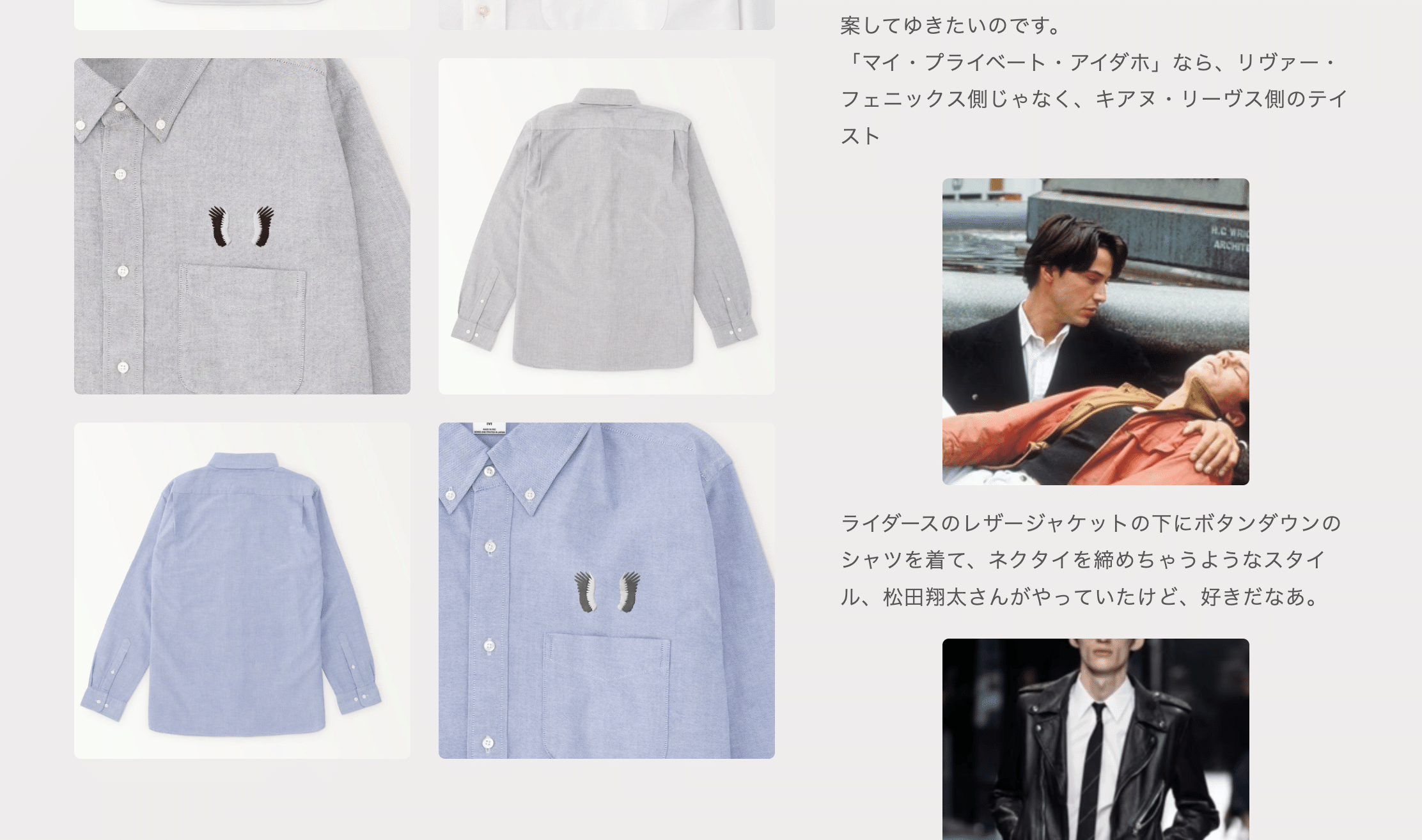
It would be presumptuous to say that we are like Honda of the past, which created a market in a place where it was not yet clearly visible, but I would like to say that we do not want to be discouraged even if we become discouraged.
It can't be helped that Honda is criticized at the current shareholders' meeting, and I hope they continue their F1 activities even if they quit and come back many times.
I sincerely hope that serious conflicts will not occur in Southeast Asia and that people will be able to enjoy their days riding motorcycles.
+++Related links+++
